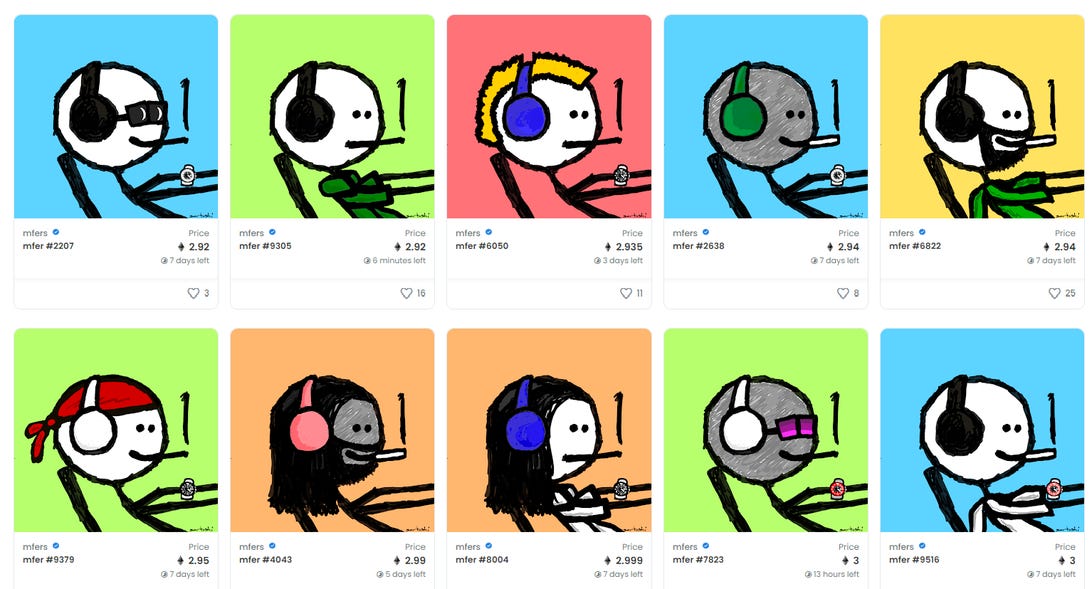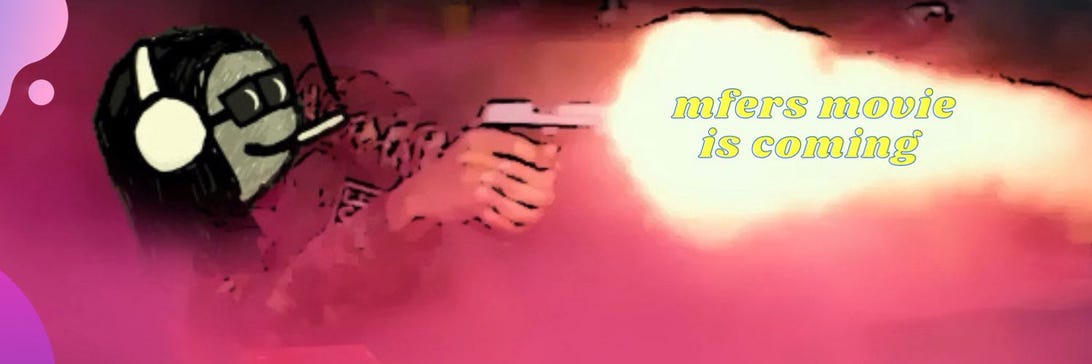
An mfer.
OpenSeaNFTs are confounding at the best of times, as people spending five figures on profile picture art is never easy to comprehend. Still, most successful nonfungible token (NFT) collections have a coherent logic to them. The crypto-rich drop six figures on CryptoPunks because it has historical value as the first ever NFT collection. They spend even more on Bored Ape Yacht Club NFTs because it’s become a brand big enough for the likes of Adidas and Rolling Stone to work with. But even if you consider yourself open-minded when it comes to NFTs, you may have a hard time accepting “mfers.”
Like the popular collections mentioned above, mfers is a set of roughly 10,000 NFTs (10,021 to be precise). Each artwork in the collection is a stick figure wearing headphones typing on an out-of-frame keyboard. Since launching on Nov. 30, over $110 million worth of mfers have been bought and sold by NFT traders, more than most Hollywood movies make in box office sales.
If you want to get your hands on one, the cheapest mfer listed on NFT marketplace OpenSea is 3.97 ether. That’s a few bucks short of $14,000.
Even when you factor in the crypto-rich backgrounds of most NFT traders — dropping 3 ether on a funny jpeg is easier if you bought ether at $40 instead of $4,000 — the success of mfers is unusual. Dozens of NFT projects are launched every day. Many are scams, more are money grabs and most of the ones attempting to be legitimate fail quickly. A tiny fraction reach the heights mfers has achieved in the past four months. It’s ranked 44 on OpenSea’s chart for all-time volume.
And it’s preposterous. Mfers is everything people hate about NFTs: simple art being sold for insultingly high prices. Like many success stories in the cryptosphere, however, it’s more complicated.
Underlying mfers’ meme art is, hilariously, an argument about intellectual property. It’s one of a few “CC0” NFT collections, which means it’s in the public domain. Its creator doesn’t own the imagery, and people are free to use the mfer brand for whatever they choose. The idea is that mfer owners will profit if the mfer brand grows, even if no one owns the copyright for it. In essence, it’s an experiment to see if it’s possible to completely crowdsource brand building.

There are 10,021 mfers, each with slightly different traits. Here are 10 of them as seen on NFT marketplace OpenSea.
OpenSeaThe collection was created by a popular Twitter personality who goes by Sartoshi, an amalgamation of “art” and Bitcoin founder Satoshi Nakamoto. It was inspired by the “are ya winning son?” meme, which according to Know Your Meme centers on a dad walking in on his son playing a VR hentai porn game. Sartoshi drew a stick-figure slouched on a desk chair, cigarette dangling from its mouth as he taps away on a keyboard, in the same style as the meme. Before it was an NFT collection, he used it as his profile picture on Twitter, where he now has over 160,000 followers.
“I do some painting and ‘real’ art myself and the idea was never to make a Mona Lisa here,” Sartoshi told me via Twitter DMs. Like most people in the Web3 world, he asked to stay anonymous. “The idea was to make a cool sketch-feeling NFT that people could identify with… and to free the copyright over the art to see what the universe decided to do with it.”
The collection dripped with internet meme culture from the beginning. Launching on Nov. 30, the public sale began at 4:20 p.m. with a price set to 0.069 ether ($230) per mfer. All 10,000 sold out instantly thanks in large part to Sartoshi’s following.
As commonly happens in the NFT market though, mfers had a day or two in the spotlight and then faded away as that shine moved on to the next attention-grabbing project. By the end of December, sales slowed down and the floor price (the cheapest someone had listed on the marketplace) fell to 0.05 ether, below the public sale price. Mfers began to recover in January and then exploded in February. Once momentum started to build — NFT collections largely sell based on hype, so momentum is particularly powerful — buyers flocked in, pushing the floor price as high as 6 ether ($18,000). Like all collections, mfers have different traits that make some rarer than others: One trader dropped 80 ether, a whopping $270,000, on this rare mfer.
The floor price has since balanced out at between 2.5 and 4 ether. That doesn’t yet make mfers a “blue chip” NFT, which typically refers to a handful of collections that can sustain a floor price of over 10 ether, but it does make mfers significantly more successful than 99% of collections.
4/ I like the fact that the mfer community is so active in creating derivatives using the CC0 (public domain) license of the mfers.
Some colleagues/friends worry that CC0 is not great for PFPs.
I am not sure they are right. In any case, it is an experiment we must run.
— 6529 (@punk6529) March 6, 2022
Sartoshi thinks mfers was able to stand out by eschewing the hype that accompanies most NFT launches. With stick-figure drawings, no one could pretend that the art was revolutionary, as many NFT creators breathlessly claim their collection’s art to be.
“Most NFT collections have art that is quite basic,” Sartoshi said, “but all these people spend money on them and all of a sudden they’re falling over at their desk saying, ‘omg the art is amazing.” I always joked that a lot of it is basically cereal box characters.”
As with dogecoin, the silliness of it all was a major appeal, spreading through NFT circles like a good meme goes viral on Twitter. Yet the success of the collection can equally be chalked up to its approach to intellectual property — a sentence that feels absurd to write. That Sartoshi made mfers a public domain collection makes it unusual. Some creators, like CryptoPunks’ Larva Labs, reserve the rights to all of the collection’s IP. Others, like Bored Ape Yacht Club’s Yuga Labs, give rights only to owners, and even then only to the specific NFT they own. (Yuga Labs last month bought CryptoPunks from Larva Labs and said it will extend the same copyrights to CryptoPunks holders as the ones afforded to Bored Ape Yacht Club owners. That one company could buy the IP for another NFT collection is another argument some make in the favor of CC0 collections like mfers, which can’t be purchased in the same way.)
“Instead of just the rails that the NFTs run on being decentralized, you extend that to the NFT,” explains Giancarlo Chuax, a former stock analyst who now runs a YouTube channel analyzing NFTs. “Compare that to a Bored Ape Yacht Club, where you have a centralized figure that controls the brand. CC0 [public domain] projects don’t have that. Anybody can take the brand in any direction they want, and some feel that’s truer to what the internet is about.”
In an industry where people really care about decentralization, it’s an idea that mfers have clung to — even if they acknowledge, as a few did during a Twitter Spaces I was invited to join, that it may end in chaotic failure.
Sartoshi has taken a completely hands-off approach, endorsing the community from afar rather than actively participating, much less leading it. Holders of mfers have busily set out to build the brand, often using their 9-to-5 skills to do so. Several have designed and produced merchandise. One of the community mods, MasterChanX, runs MferRadio, an online radio station that among other programming hosts a Shark Tank-style show appraising ideas for mfers derivative collections like 3D Mfers. One holder, Richard Chiu, has experience acting and producing in Hollywood — and so is creating an mfer movie. Someone even paid out of their pocket to put mfers in Times Square.
“The statistical odds [of success] are higher when you have unlimited creation happening,” one holder said to me.

A teaser trailer for an mfer movie.
Twitter/mfers studiosAs frivolous as mfers looks, Chaux says collections like it could significantly change how people consider intellectual property. “The idea of something coming from the ground up, bubbling up organically without the traditional incentive of owning the copyright to that imagery, [would be] pretty revolutionary,” argues Chaux. “There are some interesting examples that have done well, Cryptoadz, Nouns, mfers, but they’re all fairly new. This experiment at most is a few months old.”
Sartoshi has himself speculated that the combination of NFT technology and public domain IP could be powerful, but to him that’s not the main appeal of mfers.
“What’s the utility? Well, you can build whatever you want with them. But at the same time I’d also ask what’s the utility of a Mickey Mantle rookie card?” he said, referencing a baseball card that recently sold for $5.2 million.
“Answer: They are fucking sweet. I think some might also say mfers are pretty fucking sweet.”